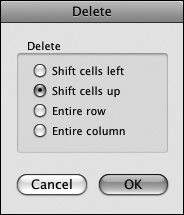In Chapter 5, you entered data into a worksheet. Now we’ll discuss ways in which you can change data that already exists in a worksheet cell.
In Chapter 5, you practiced inserting text into a blank cell by selecting that cell and then typing or pasting content. If you want to add to text that you already entered, change the text, or delete part of it, you must first activate the insertion point within the cell, either by double-clicking the cell (which places the insertion point at the cursor location) or by pressing Control+U (which places the insertion point at the end of the cell content). Then either click in the cell or use the keyboard navigation keys to position the insertion point where you want it.
After activating the insertion point in a cell, you can move around in the cell by clicking or by pressing the keyboard navigation keys (Home, End, Left Arrow, and Right Arrow). You can select text by dragging across it or by holding down the Shift key and pressing the navigation keys. You can cut, copy, or delete selected text by using the standard menu commands, keys, and keyboard shortcuts. To delete all the text in a cell, activate the cell by clicking it once, and then press Delete.
As you develop the data stored on a worksheet, you might find it necessary to add or remove columns, rows, or cells from the worksheet structure.
To insert a blank column, select the column that is in the location where you want to insert the new one. To insert multiple columns, select the columns located where you want the new ones. After selecting a column or columns, click Columns on the Insert menu. Excel then inserts the column or columns to the left of the selection.
Tip
You can select the current column by pressing Control+Spacebar, and the current row by pressing Shift+Spacebar.
To insert one or more blank rows, select the row or rows above which you want to insert the new row(s), and then click Rows on the Insert menu.
To delete columns or rows, select the columns or rows (but not both at the same time) that you want to delete, and then on the Edit menu, click Delete. Excel deletes the column or row and all the data contained therein without asking you to confirm the deletion, so take care when making your selection.
Tip
As in other Microsoft Office 2008 programs, you can undo the last change you made by clicking the Undo button on the Standard toolbar (or by pressing Control+Z), and undo multiple changes by clicking the Undo arrow and selecting from the list the changes you want to undo.
To delete one or more cells, select the cell(s), click Delete on the Edit menu, and then in the Delete dialog box, specify the direction you want the remaining content to move to fill the gap left by the deleted cells.
Tip
If you want to delete only the data within a column, row, or cell, without changing the worksheet structure, you can do so by selecting the column, row, or cell and then pressing the Delete key, instead of clicking Delete on the Edit menu.
To insert one or more blank cells within the current worksheet, select the range in which you want to insert the new, blank cells. Click Cells on the Insert menu, and then in the Insert dialog box, specify the direction in which you want to shift the selected cell(s) to make room for the new one(s).



